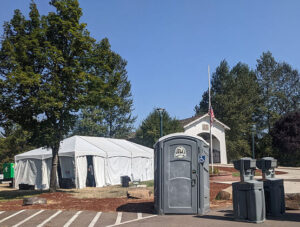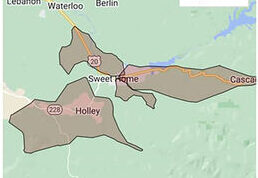By Sarah Brown, Cory Frye
Of The New Era, Lebanon Local
It all began with a forecast, albeit a familiar one with historically dire consequences.
The National Weather Service issued a red flag warning Wednesday, Sept. 7. That meant strong winds, warm temperatures and low humidity – all of which were on the menu Friday and Saturday in the Oregon Cascades.
This was enough to exacerbate already dangerous wildfire conditions, and Oregon was contending with plenty of those. Nearly 30 were then burning throughout the state, consuming more than 200,000 acres, led by the ongoing Double Creek and Cedar Creek fires in eastern and central Oregon, respectively. (As of Wednesday evening, that number had increased to 34 fires, with 300,000-plus acres lost.)
As a result, both Pacific Power and the Philomath-based Consumers Power Inc. announced the possibility of public safety power shutoffs in Sweet Home, Lebanon, Lyons, Scio, Elkhorn, Detroit, Stayton east through the Santiam Canyon, Idanha, Lincoln City, Marion Forks, Glide east along the Umpqua Highway and the Rogers Mountain and Mt. Tom areas, potentially bringing darkness to more than 12,000 customers in Linn, Marion, Douglas, Lincoln, Tillamook and Polk counties.
Impacted cities sprang into action, from law enforcement agencies and the highest levels of government to proactive average citizens. The City of Sweet Home topped off all equipment and vehicles with gasoline, the Sweet Home School District gave the Sweet Home Fire District access to its fuel reserves and the SHFD planned to use water from its water tender vehicle rather than from fire hydrants. The wastewater treatment plant filled its reservoirs to the top, hooking up generators to provide energy for itself, City Hall and the police department. (The plant was unaffected by the outages.)
Sweet Home Public Works Director Greg Springman said everything went pretty smoothly, although preparation involved some scrambling.
“I don’t think we got enough advanced warning,” he said. “That would be my one critique. When we got the notice, we started making water and all our reservoirs were topped off by the time the event came.”
The city also asked residents to limit water usage to indoor use (cleaning, flushing, washing, etc.) and to avoid watering plants or washing cars.
“That day the notice went out, we produced the largest water we’ve ever had in a day. It was like 1.9 million gallons,” Springman said. “We normally produce about 1.1 million gallons a day on average in the summertime. In the winter we only produce about .5. We just wanted customers to be mindful that we’re in an emergency event and we’re already having our power shut off, so that’s like one step away from having something else happen that really kind of magnifies the situation.”
Springman said he’s worked in a lot of emergency centers related to water districts and wildfire situations, so from experience he believed it was better to be a little more proactive, because it could potentially give residents more time to get through some of the events.

Besides, presumably, stocking up on water, Sweet Home residents prepared for the expected outage as early as 4 a.m. Thursday, Sept. 8, hitting their favorite fuel stations to stock up on gasoline for cars and generators. By noon, what they found were lines.
Stan McCann pulled into the Main St. Chevron and waited behind a couple of cars for a chance at the pump.
“They’re planning for the power outage, because when [it] comes, they’re not going to be pumping,” he said.
McCann himself, however, simply wanted to fill his empty tank. It was the same story for Bob Dennis, who already had a fuel supply for power at home, and Crystal Schatz, who needed enough to at least get her to work in Lebanon that day.
Chevron employee Amanda Altherr said the pumps had been running nonstop and, by 5:30 p.m., were down to about a quarter-supply of gasoline, which she expected wouldn’t last the next four hours before closing.
The Mobil station further down the street closed early Thursday with a posted sign alerting visitors to its empty tanks. A half-mile away, Pacific Pride received a refill of gasoline and diesel from a supplier after running out at noon, but remained out of non-ethanol.
Meanwhile, Pacific Power confirmed a shutoff for Friday and Saturday in Sweet Home, Crawfordsville, Holley, Liberty, Cascadia, Lacomb and Jordan. The Sweet Home School District responded by canceling all Friday classes, although the high school’s football team still traveled to Molalla for a non-conference game that evening. (The Huskies won, 49-14. See more on page 18.)
“Without power, it is difficult to see in dark classrooms and restrooms, prepare meals for students and, most importantly, we can lose communication services, which is a safety risk,” Supt. Terry Martin wrote in a letter to parents. “By making the announcement now, we hope you have time to plan for childcare for Friday and make other safety arrangements.”
(The Lebanon Community School District followed suit, closing Lacomb School as that unincorporated community prepared for its own imminent Pacific Power shutoff.)
The mid-Willamette Valley anxiously awaited the outage, initially scheduled for midnight Friday, then pushed to 6 a.m. and beyond. Power was still available later that morning to areas expecting to be impacted, but according to Pacific Power regional business manager Cooper Whitman, more shutdowns would be expected based on the wind.
“The wind arrived exactly as the meteorologist said, but it was just about 1,000 feet above us,” he said. “Now it’s down on the ground up the canyon a little bit, so we had to de-energize some of Sweet Home.”
That was the “first wave” of outages experienced in part of the city Friday morning. Danger to the surrounding area was “still very possible,” however, so the utility remained on standby.
“We’d rather under-promise and over-deliver, to be safe,” he said.
It was the wind and dry fuels that had the company on alert, Whitman continued, adding that meteorologists Pacific Power was in touch with stated, “At no time in history has the ground been as dry as it is right now.” He explained that whenever a branch or any debris from wind hits a power line, the power is cut for a brief period and the line will re-energize.

“But any time it does that,” he said, “it has the potential to spark. If it sparks in these conditions, then we’ve got a big, big problem. So, this is all just about fire safety. We’re just not taking any chances.”
And that’s similar to what caused Sweet Home’s “second wave,” which occurred at around 5:20 p.m. that day, Sweet Home Fire Chief Nick Tyler said. A tree limb fell onto a Cedar Street power pole, resulting in a shorted circuit.
“The fuels were dry enough that we had fire in the tree on the power line, and it threw embers to the neighbor’s house, so we had a bark dust fire at the neighbor’s property,” he said. “It burnt just limbs in the tree, and then knowing the potential, I had myself and another firefighter walk the entire block and we found that smoking bark dust fire at the neighbor’s place.”
It was sparking power lines that started what became known as the “Camp Fire” in Paradise, Calif., in 2018, although it was failure on many other levels, such as poor communication to civilians, that led to the ultimate destruction of the city and surrounding area, Whitman recalled.
The California Department of Forestry and Fire Protection determined that the Camp Fire started in the early morning of Nov. 8, 2018, from conditions not unlike what was being seen in the surrounding areas of Sweet Home. Dry vegetation, red flag conditions, strong winds, low humidity and warm temperatures prompted the fire, which started from two separate power lines and swept through four mountain communities. It burned 153,336 acres, destroyed 18,804 structures and resulted in 84 fatalities.
“That was the worst-case scenario,” Whitman said.
Oregon had witnessed such impacts, too, and they were a little too recent – and too close – for comfort. The projected weather bore an unsettling resemblance to the historic 2020 Labor Day infernos, when east winds merged the already raging Beachie Creek, Lionshead and P-515 conflagrations into the early September 400,000-acre-plus Santiam Fire that tore through various parts of Linn, Jefferson, Marion and Clackamas counties. More than 1,500 structures were lost and five people were killed. The small towns of Mill City, Lyons and Idanha were devastated while Detroit and Gates were almost wiped off the map.
Two years later – almost to the day – utility companies worked to avoid such outcomes.
Meanwhile, the Holiday Farm Fire forced Level III evacuations southwest of Sweet Home.
Hence, the emergency shutdown. According to Pacific Power spokesman Drew Hanson, the company began de-energizing Linn County circuits between 9:30 and 10:20 a.m. Friday, and Consumers Power Inc. kept a watchful eye over its 23,000 members in six counties.

To provide assistance to Sweet Home, Pacific Power and Fire Dawgs, a Yreka, Calif.-based disaster assistance company, set up a temporary community resource center Friday and Saturday for area residents at Sankey Park. A large tent erected near Weddle Bridge was kept cool by a large air unit, and snacks and a charging station were available for anyone. PacifiCorp (the Portland-based firm of which Pacific Power is part) team manager Chelsey Roth was on hand to update visitors’ account information to provide updates for the utility’s customers more efficiently.
Tim and Jennifer Rowley spent part of Friday at the center, engaging their children in various activities as Jennifer recalled the moment the power went out in their Sweet Home household.
It happened in the “first wave,” she said. Her kids took a nap, then went swimming in their pool before heading to Sankey Park to visit the resource tent. For the rest of the expected outage, they were prepared with camping gear and the water they’d pulled from their well ahead of time.
“We love board games, so we’ll be fine,” she said.

Sweet Home Police Department Captain Jason Ogden and Fire Chief Tyler addressed the community via Facebook video that day, outlining their plans for the weekend’s anticipated event.
“We have been working closely with Pacific Power,” Ogden said. “We just wanted to reassure you that we’ve been taking this potential weather event pretty seriously. We activated our emergency operations center this Wednesday and some of the players have come together.”
He added that both agencies were working with the school district, Linn Shuttle, Sweet Home Public Works and the Oregon Department of Forestry to determine any next steps.
“We’ve obviously learned a lot from the 2020 fire season,” Tyler said. “There are some similarities with the forecasted weather coming this way with the east Linn high heat and low relative humidity, which is concerning.”
Community partners had identified issues and lessons learned from 2020, which helped the department implement plans and preparation for any potential event, he said, adding that an Office of the State Fire Marshal task force was in the county, ready to support.
“Things are changing by the moment,” Tyler said. “We have plans for fuel, plans for water; everything’s in place and you guys can rest assured that Sweet Home’s going to be very well-protected.”
He urged patience with Pacific Power.
“(It’s) doing everything it can to be in front of this,” he said. “Some of the information that got pushed out early was worst-case scenario, so things are changing with them hour-by-hour. They’re prepared to secure the power to eliminate any potential fire threat for us, which is something we learned in 2020 and moving forward.”
Although the wind seemed relatively mild in town at the time, he said, the Hoodoo Butte weather station was reporting 50-plus mph east winds at the top of the Santiam Pass.
Ogden said the police department would provide increased patrols, particularly during the evening, and encouraged residents to report any suspicious behavior.
“You’re not going to be bothering us,” he said. “We want to know about that so we can respond to those things and make sure you all feel safe.”
“I have a family in the community, too, so I understand the frustration” that shutoff times keep changing, Tyler said. “We just ask that everybody be flexible. Have patience with Pacific Power and know they are doing it to keep our community safe.”
The shutoffs eventually commenced Friday morning, and, later that evening, a Pacific Power outage map listed almost 6,000 customers in the area without electricity.

Many affected residents said they either headed out of town or indulged in more calming pursuits during that time, such as reading or playing games. They equated it to camping at home – with a few essential conveniences, of course.
“Our food was cooked outside on a campstove,” Joy Kistner said. “We read books next to the lantern and used a flashlight in the bathroom. Though we did sleep in our regular bed, not on an air mattress.”
Diane Golden and Lori King reiterated what others said, that it was fun to pretend they were camping. Golden’s family read, played board games, reminisced about funny memories and told ghost stories. King read under a headlamp and enjoyed the quiet stillness outside.
But for some, it wasn’t so quiet. The east winds kept Lily Jacks awake most of Friday night. Others, however, saw those gusts as enjoyable, a respite from the ones blowing endlessly across social media. Jan Hufford took a breezy walk while Darcee Baughn listened to her chattering wind chimes, felt the wind on her face and “watched the beautiful full moon rise over the mountain.”
They certainly weren’t alone, because other weather-related outages dotted the state, too. Lights went out in Stayton east through the Santiam Canyon, Scio, Lyons, Lincoln City and Glide east along Umpqua Highway, Sublimity, Detroit and Mill City, affecting roughly 9,000 Pacific Power and 1,000 CPI customers. By Saturday morning, Portland General Electric had cut power in the Mt. Hood corridor and foothills, the Columbia River Gorge, Oregon City, Estacada, Scotts Mills, the Portland West Hills, the Tualatin Mountains, North West Hills, Central West Hills, Southern West Hills, Silver Falls, Silverdale, Corbett, Southwest Scotts Mills, South Molalla, George, Colton and North Sandy. Nearly 40,000 addresses were impacted.
“The event from the community standpoint was kind-of a bust because they didn’t see big heavy winds, but the event was real for us as far as the risk of fire danger,” Tyler said. “The east wind event in and of itself is scary, even if you don’t have high winds. The hot, dry air that the east winds bring in – so when you’re looking at high temperatures and low relative humidity – that is what we saw in Sweet Home. And you could see that in our surrounding areas where Salem had evacuations, Estacada had evacuations. That’s very unusual, especially for Salem. The increase in temperature and decrease in relative humidity is cause for events to happen. So even though people didn’t see trees blowing over and big heavy winds, that wind event was here and I think the power company did a great job in helping mitigate some of the risk.”
Power began returning to the Sweet Home area early Saturday afternoon, Sept. 10, falling to 224 Pacific Power customers, then 29 by 5 p.m., at which point the utility sent a news release confirming that the shutoffs had ended and service had been restored. (CPI was down to 444 in Linn, Lane and Lincoln counties by that time.) Hanson reported that the outage on most circuits lasted between 17 and 20 hours.
“Community safety and reducing wildfire risk are top priorities for us,” Vice President of Operations Allen Berreth said. “We thank our customers for their patience and understanding through this event. I also acknowledge the all-hands-on-deck approach from Pacific Power personnel. Our team emphasized safety for our customers, communities and co-workers. We thank the crews patrolling and repairing lines, the staff monitoring conditions and volunteers at the community resource centers.”
Springman is convinced that planned power outages will be the new norm.
“PG&E has already been sued in California with Paradise,” he said. “You’ve got Pacific Power being sued by people up in Gates. This procedure they went through was very well-planned-out from them. They’ve been planning for a while; they had a lot of stuff happen real quick.”
But it was that kind of preparation that readied the city for any major related events and gave some residents a sense of appreciation, despite the inconvenience.

“I think Pacific Power made the right decision,” resident Pam Marie said. “Better safe than sorry, and after seeing the devastation two years ago up in Detroit and the North Fork, I was really glad they decided to do what they did. I’m so glad to be home, though, and think our city needs to think about this new-normal situation and have plans in place for next summer.”
King agreed that the power outage decision was a good one, but she would like to see the city publish a plan for evacuations and assistance for those who need help evacuating, should it ever come to that.
“Pacific Power did a good job of trying to balance what I would say my needs are, or the fire risk concerns in ensuring that people had power,” Tyler said. “The (city) leadership did a great job of planning, and so many of the lessons learned from 2020 and just being prepared was huge.”




